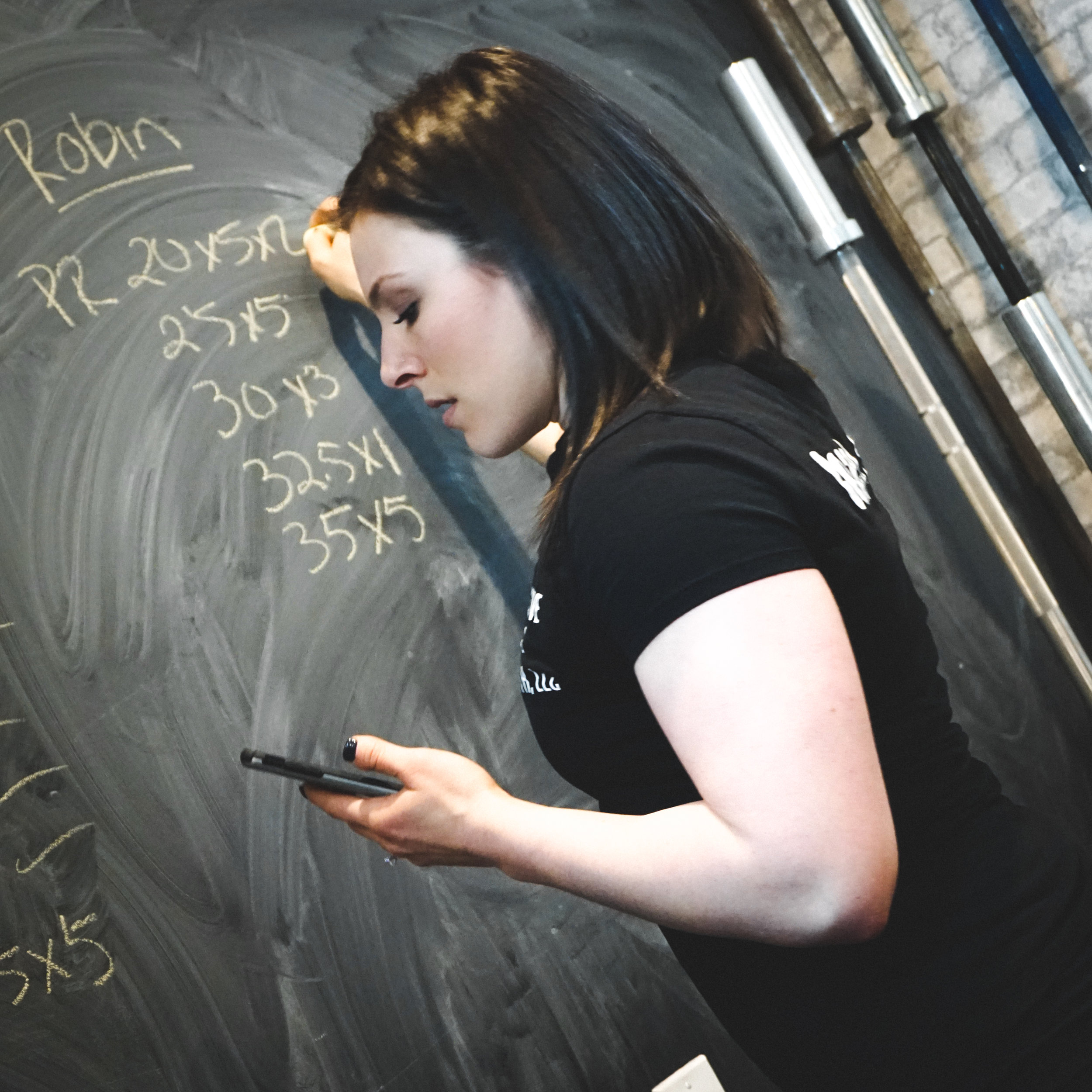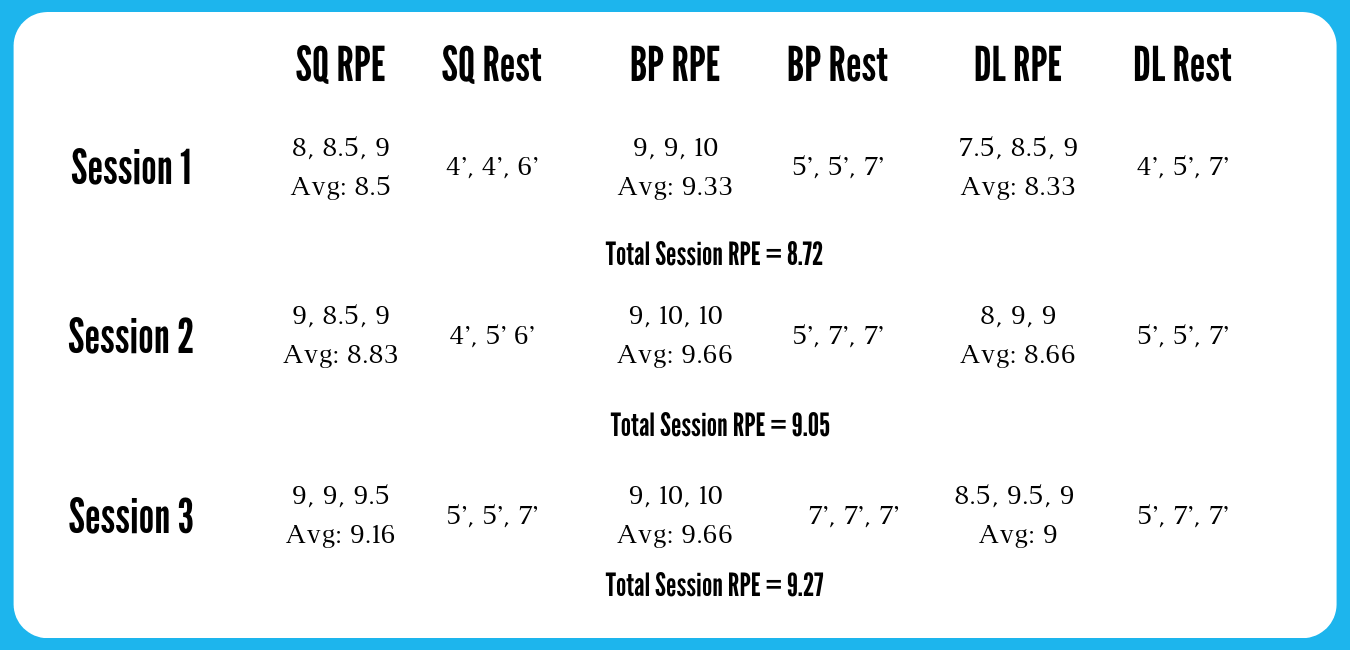You’re following a templated program like 5/3/1, SS NLP, Texas Method, Cube, Conjugate Method, HLM, and you’re doing it alone, without the help of a coach.
You’ve read the books and the articles that come along with your program but aren’t quite sure exactly how to transition your program along the way.
What happens when work sets get too hard? The biggest mistake self-programmed lifters make is missing the optimal window to change a variable before things go awry. Even novice and experienced coaches do it. And we commonly see injuries, missed reps, repeated workouts, spinning wheels, regression, training anxiety, loss of training motivation, or even quitting altogether as a result..
Why? Because volume and intensity weren’t adjusted at the cusp of a fatigue disaster.
RPE and Subjective Effort
How “hard” something feels is a relative experience for each person. It’s related to how much force you can physically produce at the time you execute a movement.
225 pounds will always be 225 pounds on a scale. But that same weight can feel completely different to two people trying to move it. It can even feel different for one person who might train first thing in the morning or at the end of the day.
At Progressive Rehab & Strength, we use the RPE (rate of perceived exertion) scale to help lifters identify how difficult a lift is for them at any given moment. Most of the time, athletes give an RPE on a 1-10 scale, where 1 is the RPE of laying in bed staring at the ceiling, while 10 is the RPE of an all out max-effort or failed rep. RPE can help us identify disaster knocking at the door before it lets itself in, especially when we take objective and other subjective fatigue factors into account. For more in-depth information on RPE, and how to use it, check out the article RPE: Am I Doing This Right?!
RPE for a single set, all sets for a lift, and the accumulated average RPE for the training session can give us valuable insight as to how hard each individual athlete finds each lift, and each training session overall.
Fatigue
Fatigue is the physiological response to repeated force production that produces a change in your physical ability to execute or your psychological responses to exercise.
Physical fatigue can be seen within a session as the relative intensity of the same load increases across sets. For example, if you give the first set of a 5x5 an RPE of 7, and give the last set an RPE of 10, the same weight is feeling subjectively heavier. We also see that intra-session fatigue when your form starts to break down within a set, from set to set, or when you need more rest time to feel ready to perform your next set.
Physical fatigue can also manifest as an increase in RPE from session to session, a drop in your estimated 1-repetition maximum across a few sessions, or increased soreness or tiredness going into your next training session.
Psychological fatigue manifests within training sessions when you find yourself needing to get more and more aggressive to hype yourself up before working sets and grunting or yelling with more than half your working sets and reps. You might start to develop feelings of dread going into your next session, worrying that you’ll miss reps, wanting to push training off another day, or wanting to skip the gym entirely.
You started strength training because you wanted to get strong, compete, be useful, change your body composition, or improve and maintain your health for a very long time. The worst thing possible would be for this healthy habit to come to a screeching halt because of an injury or loss in motivation entirely due to accumulated fatigue.
Using A Training Log
One of the most important factors in avoiding fatigue is your training log. Your training log will help you see trends in your training over time. You don’t even need a fancy online log or expensive app. Just keep a paper training journal and track your RPE for each set. Note how long you’re resting between working sets.
These records will allow you to glance quickly at the previous few workouts for comparison. If you want to get crazy, you can average the RPE for the working sets of each individual lift, and then average the RPE for the entire training session. An example of all of this is below:
To keep making progress, you need the appropriate amount of training stress to cause an adaptation without causing too much fatigue. With that in mind, outside of total training volume, we suggest your relative intensity stay between 7 and 9 RPE with the average RPE for each lift not exceeding 8.5 RPE for more than 3 sessions in a row.
Adding Rest
Once you’re familiar with logging your RPE, finding your average RPE on an individual lift is the first, and simplest, place to start. Once you notice that your average RPE on a certain lift is regularly above 8.5, the first change you should make is to add rest time. However, we get it. Life goes on outside the gym, and you may not be able to rest for 10 minutes between sets. Some people start to get bored, or start to hate training if it takes too long, so the upper limit to your rest time might be different than someone else’s. That’s okay! Cap your rest time at what works best for you.
If you’ve capped out your personal rest time allotment, but your average RPE is still climbing over 8.5 for more than three sessions in a row, you may want to start thinking about making a change after the third training session of RPE 8.5 or higher in a row.
Why not make a change after the first or second high RPE session? Because of randomness. These tough sessions can be total anomalies. Maybe you didn’t sleep enough because your 10-week-old is teething. Maybe you didn’t eat enough because you left your lunch in the car all day and it spoiled. Maybe you were distracted by some hottie walking in front of the squat rack. There are any number of factors in your life that can make training more difficult. So we wait it out two or three sessions to see if your average RPE comes down after adding an additional minute or two for rests and remembering to put our lunch in the refrigerator at work. The only time we don’t suggest waiting it out any longer is if all sets are 9.5+.
What Changes Can (and Should) You Make?
The changes you’ll make depend on where you are in your training, what programming you’re following, and who you are (age, sex, body size, advancement level, etc.).
Sets Across: “Sets across” means that the weight stays the same for all working sets. If your training calls for higher rep ranges, one initial change can be to drop the number of reps per set and increase the total number of sets. You’ll maintain about the same total volume, but hopefully lower the relative intensity (RPE) of each set. We apply this rule to rep/set schemes with 25 total reps or fewer. Some examples of this are below:
5 reps x 3 sets across → 3 reps x 5 sets across
6 reps x 4 sets across → 4 reps x 6 sets across
4 reps x 4 sets across → 3 reps x 5 sets across
Drop Sets or Back Offs: Drop sets and back offs describe a scenario when there is a heavy set at a higher weight, and the rest of the working sets are performed for the same number of reps at a lesser load, typically 5-10% less than the top load. Drop sets are used in the following scenarios:
Work set volume greater than 25 reps
The 1st set of sets across is 8.5+ or less but the remaining sets are RPE 9+ and the lifter is a young, healthy male
A change has already been made from sets across to lower volume sets to maintain the total number of reps (see sets across scenarios above)
Examples of the change to drop sets are below:
5 reps x 3 sets across → 5 reps x 1 set/5 reps x 2 sets @ -5%
3 reps x 5 sets across → 3 reps x 1 set/3 reps x 4 sets @ -7%
4 reps x 6 sets across → 4 reps x 1 set/4 reps x 5 sets @ -5%
8 reps x 4 sets across → 8 reps x 1 set/8 reps x 3 sets @ -10%
You can then continue to apply changes to the Drop Set scenario by lowering the number of reps and maintaining the volume as best as possible.
5 reps x 1 set/5 reps x 2 sets @ -5% → 3 reps x 1/ 3 reps x 4 sets across @ -7%
4 reps x 1 set/4 reps x 5 sets @ -5% → 3 reps x 1 set/ 3 reps x 5-6 sets @ -7%
3 reps x 1/ 3 reps x 4 sets across @ -7% → 1 rep x 1 set/ 3 reps x 4-5 sets across @ -10%
Next Steps
If you’re still experiencing an extremely high RPE in every session and have exhausted all other possible changes, it might be time for you to either transition that lift from novice to intermediate programming, or reset your intermediate program and run it from a higher starting point. Congratulations. You’re getting stronger! You can also read our free guide to healthy barbell training here.
But don’t think I forgot about that pesky session RPE I mentioned earlier. If you’ve got the ability to keep track of that, session RPE can help you decide when it may be a good time to split your work over more days. Traditionally, most strength training programs are designed on a three-day rotation, which continues from the novice phase into the early intermediate stages. However, in some cases, the stress and fatigue from one lift affects your performance of subsequent lifts.
We can get some sense of this by assessing session RPE the same way we assess average RPE for individual lifts. A good place for session RPE to be for positive progress is in the RPE 8-9 range. When session RPE clocks in at 9+ for a few sessions in a row, with an associated drop in performance in the later exercises of the training session, and if you’ve already made rep scheme changes, it’s likely time to switch to a 4-day split. We’ll talk about a few types of 4-day splits in the next programming article!
For now, you should hopefully have some tools to help progress your training without failing reps, injuring yourself, or becoming so unmotivated by training that you throw in the towel. We know programming is challenging and you shouldn’t have to do it alone.
To take the guess work out of this, we've created an entirely free program that utilizes the exact principles + the PRS System secret sauce to help guide you (or your clients) on your strength journey. If you're an athlete, coach, or clinician, download our free program HERE to make training easier, optimal, and more enjoyable for everyone.


